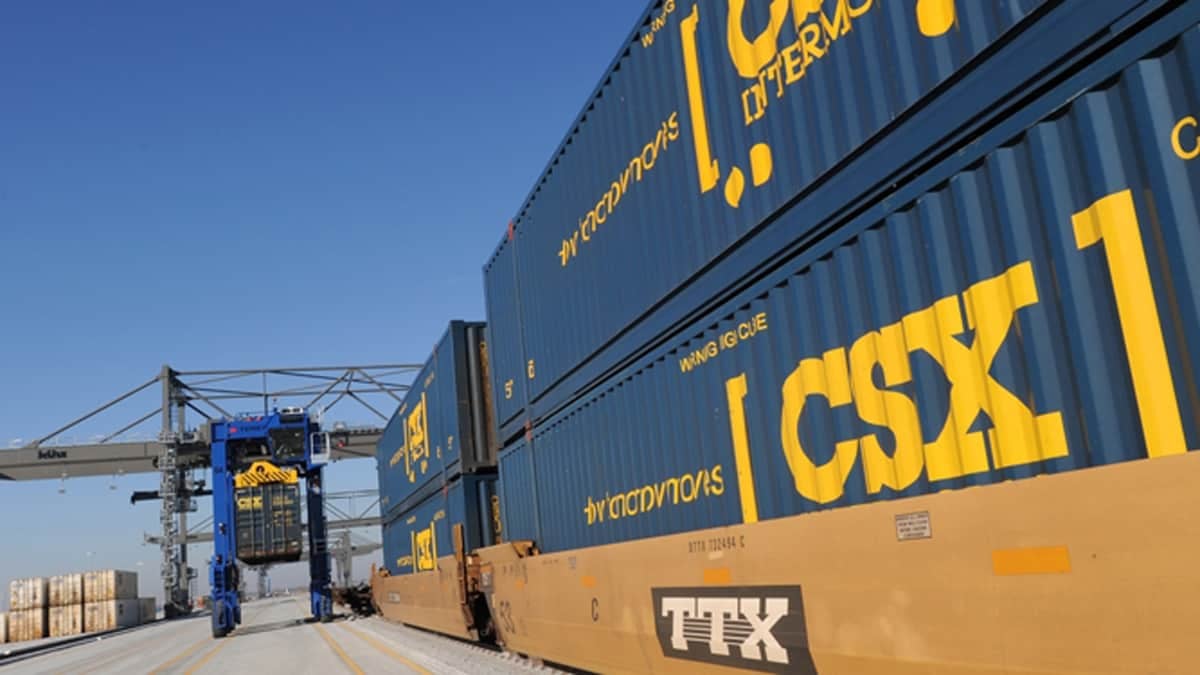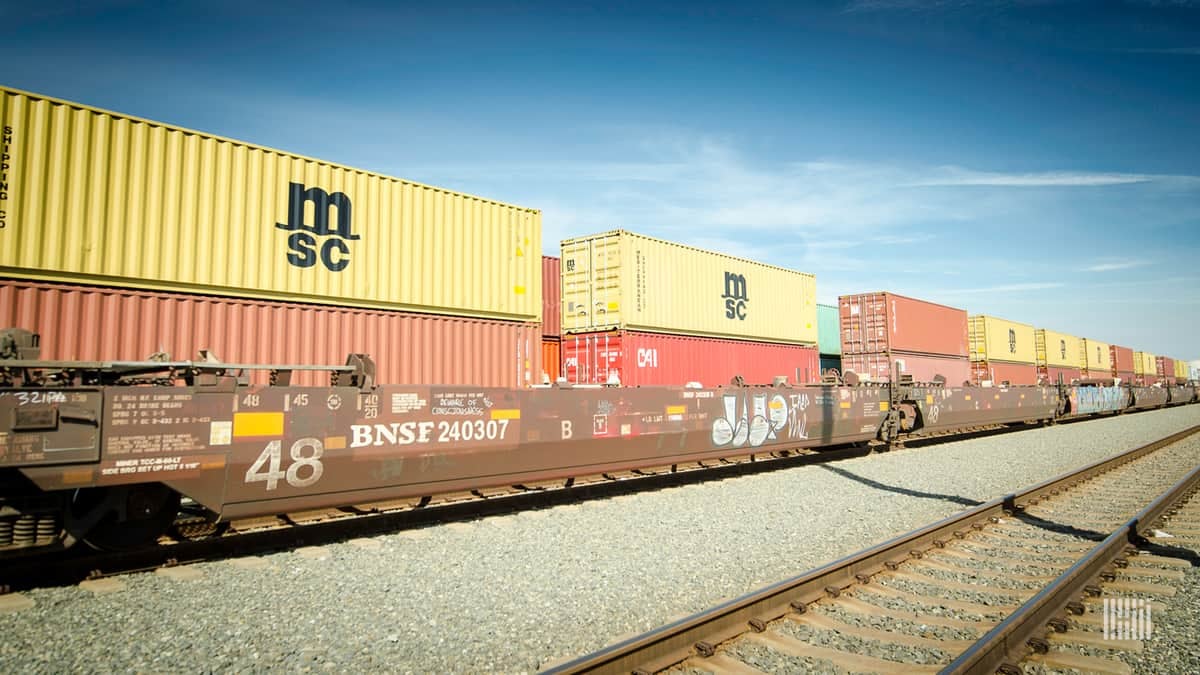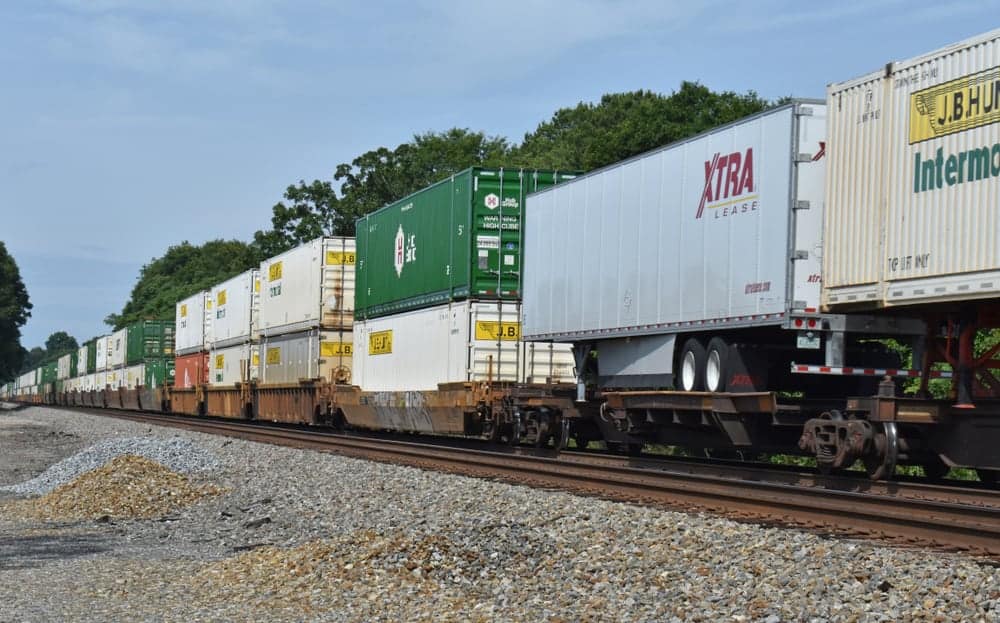Premise: The golden age of railroads taking trucks off of the highways might be over.
Why? Because the low-hanging fruit may already have been harvested.
Translation: Most rail intermodal traffic may be in fewer than two dozen origin-destination lanes across the United States. That was the low-hanging fruit.
Reading the footnotes behind railroad market literature, “intermodal does best in high-density traffic lanes over long distances.” Intermodal marketing, public relations and advertisements admit to this.
The growth hurdle is that there just are not that many high traffic volume lanes left to exploit. Growth year-over-year can continue. But it likely will not seize chunks of trucking’s share from the highways.

Where is the traffic?
If rail intermodal is going to take trucks off the highway network and simultaneously provide traffic relief to the road network, two maps illustrate where this geographically should occur.
Most of the truck and traffic congestion is east of the Mississippi River. Figure 1 identifies where the truck and auto highway congestion is located.
Figure 1

regional commerce.
Most market-to-market freight flows not yet using rail intermodal are nestled between these short distance business clusters in the eastern part of the nation. This map source is from a Brookings Institute Freight Analysis report.
Federal highway studies by U.S. Department of Transportation and the Federal Highway Administration planners project this concentration of traffic lane congestion will grow out largely in the eastern USA towards 2040.
Much of the freight moves as smaller packaged shipments in 100-mile to less than 300-mile stretches.
From a public policy point of view, intermodal services that might be redirected from long-haul corridors to the much shorter closely clustered markets in the eastern U.S. could help reduce local road accidents. But only if a new intermodal business model evolved.
Figure 2

Figure 3 helps visualize where the short- to medium-distance freight markets are as a series of concentric market circles. Overwhelmingly, the nation’s markets are a series of short origin-to- destination locations.
Figure 3

Why doesn’t this concentric short distance market pattern fit the rail model?
It doesn’t fit because that rail model relies on container freight engineering called the doublestack container car. That service doesn’t cater to hauling semi-trailer trucks. It has to move containers.
Not every shipper’s supply chain uses containers. Not every shipment can fit into a container.
The double stack rail car does fit well as the engineering solution across the long western railroad routes. That’s where large day-to-day volumes of containers move between the western U.S. ports and the Midwest markets.
This stacked intermodal carrying capability dates back to 1977 when the Southern Pacific Railroad and American Car & Foundry designed the first true “double stack” railcar – each railcar capable of handling two 40-foot containers.
The ocean carrier APL Lines initiated the stacked container trains around 1984 as a means to avoid the much longer transit times via the Panama Canal in order to deliver containers from Japan, Korea and China to the U.S. Midwest and East Coast markets.
For the railroads, the long stack train was indeed a market breakthrough.
The long-distance stacked container train offered exceptional economic improvement to the ocean carriers, the railroads and to their shipping customers.
A study for Burlington Northern Railroad by ZETA-TECH Associates in 1990 calculated a cost to move savings of 45% on the rail route from Seattle to Chicago. That estimate was later confirmed by other consultants. The stack container trains became the primary intermodal model.

Here are the primary SWOT (Strengths/Weaknesses & Opportunities/Threats) analytics of intermodal.
The strengths of stack trains are:
• Greatly improves net-to-tare ratio, since a single double stack “well” intermodal car weighs only 17 tons, compared to 35 tons for a conventional flatcar carrying the same two containers.
• A long stack train carries more containers per foot of train length, thus avoiding the capital expenditures investment otherwise needed to lengthen railroad train passing sidings.
• Each stacked container train can move nearly 250 highway 40-foot trailer truck units along the selected high density corridors – now expanded to well over 340 or more 53-foot long North American highway trucks.
This SWOT opportunity made it possible to almost entirely reverse the trucking-dominated traffic flows between the Southern California markets and the Chicago/Midwest markets in the years between 1980 and 1990.
What are the apparent SWOT weaknesses?
The biggest disadvantage is that the engineering advancements could only move containers, not trailers. The trucking market is largely semi-trailers.
Another weakness is that the stack trains require high volumes, as well as big terminals with expensive loading cranes. Not every railroad yard is easily converted to stack train service.
A SWOT threat is that the early units were fitted best towards moving the international maritime containers that are denominated in twenty-foot equivalent units and forty-foot equivalent units.
The threat to railroad business growth was that semi-trailers offered greater cubic capacity with 45-foot and 48-foot lengths. Then 53-foot long trailers appeared.
The SWOT opportunity to build the market occurred in 1990 when the Burlington Northern Railroad purchased its first order of domestic 53-foot length containers. The railroad acquired about 25,000 of these containers. The other railroads followed by adopting the 53-foot stackable containers as the new intermodal model.
By about 1996, it became clear that with high volume lanes, the competitive distance favoring rail intermodal was in the 750-mile range. A few markets “might” have presented a 500-mile or so competitive distance opportunity.

The problem child for intermodal became the old trailer on flatcar (TOFC) semi-trailer market segment. TOFC is the movement of semi-trailer highway equipment. Moving trailers on rail intermodal trains has been in an unquestionable long-term decline. In periods of extreme high traffic demand and low supplies of drivers or trucks, we see occasional spikes in TOFC volumes. This happened at times in 2018. However, the TOFC spike fades and the loss of TOFC volume reappears.
Is there a SWOT opportunity for a return of the TOFC volume to the railways? It probably requires the invention of an affordable new rapid load/unload mechanical rail car.
Another strategic opportunity could be short-distance inland port hubs. A study around 2003 suggested that dedicated shuttle trains might be viable for moving maritime containers between the Port of New York/New Jersey and as many as 10 inland port terminal depots. Among these were proposed hubs near Albany, New York (150 miles), Syracuse (284 miles), Buffalo (437 miles), and perhaps Pittsburgh (427 miles).
None of this happened. There are rumors of a possible hub near Syracuse as Canadian National Railway acquires the CSX Syracuse-Montreal branch line. Time will tell if this works.
So far the evidence is clear that the two eastern railroad carriers (CSX and Norfolk Southern) couldn’t make short-haul intermodal a profitable business model. Neither could the port authorities.
However, there are a few exceptions that might suggest short-haul optimism.
Virginia and West Virginia started two inland ports. The one in West Virginia is closing. The Virginia hub continues but hasn’t really expanded. Georgia, North Carolina and South Carolina are operating or proposing several inland container port depots.
Research suggests that there is some form of subsidy required to make the current inland port model work. There is no published information that shows that these short-haul patterns are independently sustainable as a pure private business capital and operating investment.
In contrast, the long-haul intermodal lanes are sustainable and privately financed.
The good news is that the Florida East Coast Railroad (FEC) does operate a short-haul service between Miami and the Atlanta market (in interchange with Norfolk Southern). That appears to be the most successful current short-haul intermodal operation during the period 2000 to 2019.
But note – it’s not being widely adopted by other railroads.
And previous sprint-like short-distance routes along the Chicago-St Louis and Chicago-Minneapolis lanes were tested. But they were then shut down.
The Canadian Pacific Railway TOFC trailer-focused market in eastern Canada was also tested and as the train set equipment aged, it too was shut down (in the summer of 2018). The conclusion is that whatever its profit margin, it didn’t fit with today’s often investor-centric business return expectations.
Railroad Market View conclusions as 2019 closes
The short-distance deal killer aspects of rail intermodal center on the following business fundamentals.
1) The cost of the required local trucking drayage movement to reach a rail intermodal terminal are a hurdle. Furthermore, driver shortage issues that impact long-distance truckers also impact rail intermodal drayage.
2) The cost to lift-on and then lift-off an intermodal unit also affects the rate differential versus direct trucking shipper-to-receiver short distance competition.
3) Those two drayage movements and the “lift” factors can negate as much as one-third of the cheaper rail rate assumption.
4) There often is one-quarter to one-half day or longer train departure delay to factor into a shipper’s logistics cost model if they select short-haul intermodal.
5) These don’t add up to an overwhelming intermodal advantage.
6) Something basic is missing.
Few shippers or Class 1 railroads are saying “I have to get one of these short haul routes!”
In a 2004 analysis offered by Dr. Edward K. Morlok (University of Pennsylvania), he showed evidence by using a regression analysis “that the drayage cost clearly dominates as a limiting intermodal service factor.”
At a haul distance of 200 miles, drayage can be about 75 % of the total rail intermodal cost. At 500 miles, it drops arguably to about two-thirds of the total cost – but is still a large inhibiting factor.
Unfortunately, depending upon market timing, drayage costs can actually range to as much as $300 or more per dray movement. That is a really a big wild card in any supply chain model.
Add to these drayage costs some uncertainty of time to dray, time to load, and time that containers might be held for the next departing long train – and the short-haul intermodal model is risky.
Intermodal often has too many organizers and “doers” involved. Complexity breeds uncertainty. Coordination among multiple players is more complex than is a direct single truck origin-to- destination movement.

Upside?
Yes, there are possible solutions. But short-haul intermodal is mostly still a working theory as we enter the year 2020.
Recommended references for readers to obtain alternate short haul opinion outlooks
- Adie Tomer and Joseph Kane – Joint market study by Brookings Institute and JP Morgan – Mapping Freight: “The Highly Concentrated Nature of Goods Trade in the United States.” URL report is found at: https://www.brookings.edu/wp-content/uploads/2016/06/Srvy_GCIFreightNetworks_Oct24.pdf
- Ted Prince – independent intermodal expert with hands-on operating experience.
- Chris Rooney, CFA – Vannesco – Jacksonville, Florida. Independent expert on the use of unique semi-trailer mechanical platforms for intermodal rail cargo.
- Larry Gross – independent intermodal business analyst and author.
- John C. Spychalski, Professor of Logistics at Pennsylvania State University, and Professor Evelyn Thomchick also at Pennsylvania State University – “Drivers of Intermodal Rail Freight Growth in North America” – EJTIR report, March 2009.
- Randolph Resor and J. R. Blaze – ZETA-TECH ASSOCIATES, Inc. “Short-Haul Rail Intermodal: Can It Compete With Truck?“ (2004). URL is at: http://www.harscorail.cn/intelligent-solutions/zeta-tech-consulting/sample-reports.html?task=document.download&id=329










